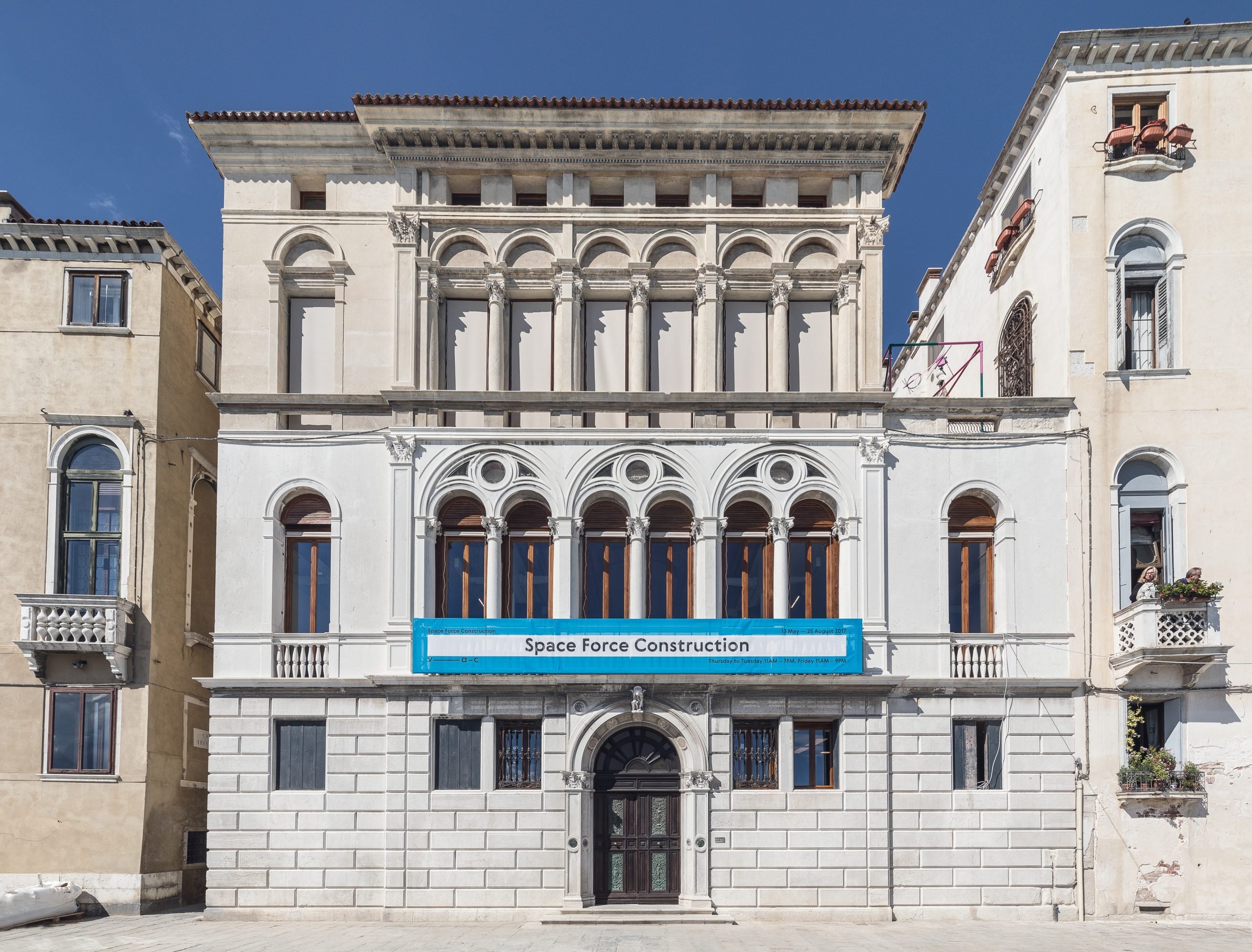
The V-A-C Foundation’s new long-term Venice headquarters launches not with a bang, but with the gentle sound of squishing clay, the tinkling of optometry lenses, and the warmth of human song. Backed by energy tycoon and art collector Leonid Mikhelson—who ranked first in last year’s Forbes Billionaires List in Russia—the canal-side exhibition and residency space opens with “Space Force Construction,” a show of modern and contemporary art from Russian and international artists.
Co-curated with the Art Institute of Chicago, and featuring museum loans from the State Tretyakov Gallery in Moscow—among them Liubov Popova’s titular work, Space Force Construction (1921)—the exhibition orbits around artist-associated works made after the October Revolution of 1917. Ranging from a workers’ social club designed by Aleksandr Rodchenko to imperious orders written to Stalin by his young daughter, these historic artifacts are shown alongside recent and commissioned works, many by artists that explicitly engage with contemporary politics, among them Tania Bruguera, David Goldblatt and Wolfgang Tillmans.
Aleksandr Rodchenko, Workers’ Club, International Exposition of Modern Decorative and Industrial Arts, Paris, 1925, replica constructed 2017, wood. Photo by Sisto Legnani.
However, despite having internationally renowned artists, major institutional partners, and prestige loans, V-A-C’s presence in Venice reads as a studious attempt to avoid the clichéd pitfalls of the arriviste collector flashing muscle alongside the art world’s most spectacular jamboree. Sure, the show is speckled with familiar names, but it’s not structured around bold-print major works. Instead, the atmosphere is one of collective enterprise.
To be fair, much of the historic material in the exhibition comes in the form of contemporary reproductions (derived from photographs and accounts of exhibitions of constructivist art or drafted designs for unrealized structures). This has the healthy effect of sapping the inviolable aura of works by Rodchenko, El Lissitzky and Gustav Klutsis, allowing them to be arranged rather casually as they might first have originally been presented, and to generate interesting friction with new works by David Musgrave, Florian Pumhösl, and Barbara Kruger.
Matthew Witkovsky of the Art Institute of Chicago, who has co-curated the show with Katerina Chuchalina of V-A-C, describes these reconstructed displays as the intersecting point between their two initial areas of interest. Witkovsky will open an expanded version of the historical portions of the show in Chicago this October, while Chuchalina and V-A-C’s interest lies more firmly in supporting Russian artists in the contemporary sphere.
El Lissitzky, Room for Constructive Art, Internationale Kunstausstellung (International Art Exhibition), Dresden 1926, replica constructed 2017, painted wood, metal, and fabric. Photo by Sisto Legnani.
Peter Taub, former director of performance programs at Chicago’s Museum of Contemporary Art, has put together a schedule of live works, most of which will be clustered around the opening week of the Biennale. In the first gallery, flanked by a wall of Leninist iconography and artist-penned propaganda posters, Tania Bruguera will perform Isasthenai (part of The Promise of Politics). The piece involves the artist sculpting and then destroying clay portraits of visitors. In a mocked-up optician’s office, Pablo Helguera and Yevgeniy Fiks present Óptica Bronstein, a “perception test” inspired by the period of Leon Trotsky’s exile in Mexico. Sergey Sapozhnikov‘s Tatlin-esque structure dressed in cheap and cheerful, taped-together inflatables will host a dance work prior to its inevitable detumescence.
The building—an unshowy nineteenth-century palazzo west of the Zattere vaporetto stop—is large but not grand, and its galleries are modest in scale. It’s not a site, in other words, destined for displays of monumental, ego-driven, collection-waggling art. Indeed, Mikhelson’s name appears nowhere on the building nor this exhibition’s attendant literature. This is less the home of a collection than a project space, set to house Russian and international artists on residencies alongside a year-round exhibition program.
If “Space Force Construction” and earlier exhibitions in Moscow are an augur of the way things will go, bookish and earnest, but not without humor, it seems to be the V-A-C’s chosen route for the time being. Certainly the Venice commissions from young Russian artists tend heavily toward archival research and deep thought.
Kirill Gluschenko, Venets, (2017). Courtesy the artist
Kirill Gluschenko, whose artists’ book and audio projects were the subject of a V-A-C show in Moscow in 2016, here recreates a room from the Hotel Venets in Ulyanovsk—a vast structure erected in 1967 to mark the Revolution’s 50th anniversary. It was made in honor of the city’s most famous son, Vladimir Ilyich Ulyanov, better known as Lenin. Gluschenko’s research uncovered images and press coverage of the hotel at the moment of its glorious opening. The optimism gleaned from these archival documents of the hotel contrasts heavily to the grim reality depicted in Gluschenko’s photographs of the now deserted structure. Shot over the course of two weeks, each night the artist would stay a floor closer to the hotel’s rooftop bar, the Olympus—hence the title to the accompanying book, Ascension into Olympus.
Mikhail Tolmachev SLON, (2017). Installation with slide projection. Courtesy the artist.
Mikhail Tolmachev brings together photographs of the first gulag labor camp, made as a gift to writer Maxim Gorky during a propaganda visit to the correctional facility. These images are interspersed with pictures from the private photo album of one of the camp guards. All the photos are projected from a theatrical structure that makes evident the whole pretense of the episode.
Curious as it may seem for a Moscow-based foundation to open its first permanent venue in Venice, V-A-C has sentimental links to the Italian city and its Biennale. It was here that Mikhelson met the outspoken Naples-born curator Teresa Iarocci Mavica, some ten years ago. Having delivered Mikhelson an unceremonious critique of his collection, Mavica suggested that he turn his attention instead to contemporary art. Mikhelson went on to launch V-A-C with Mavica as director in 2009, and the foundation was one of the main sponsors of the 2013 Biennale.
“Space Force Construction” will be on view at V-A-C in Venice, Palazzo delle Zattere, Dorsoduro 1401, Venice, Italy, May 13–August 25, 2017.